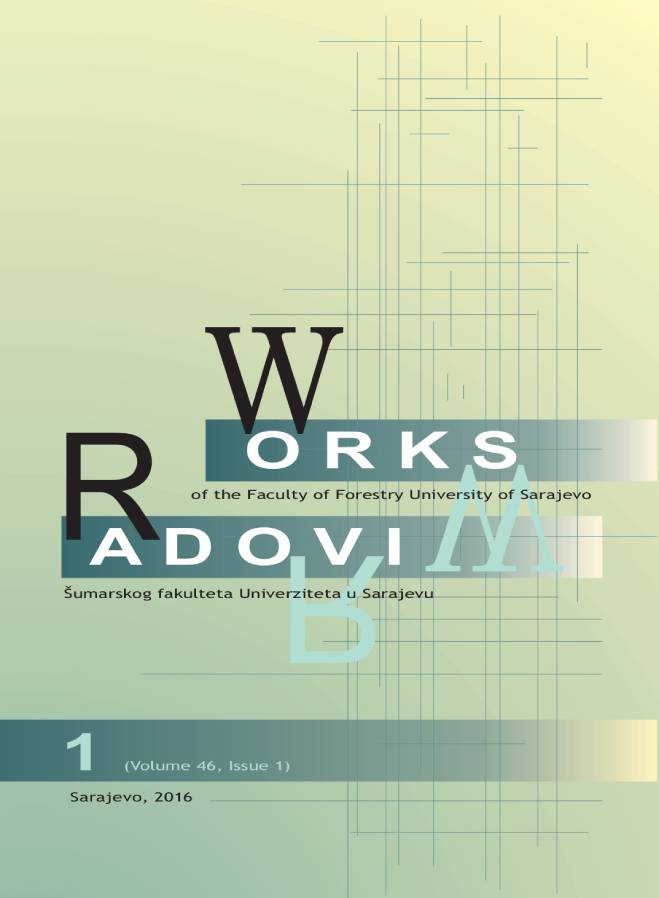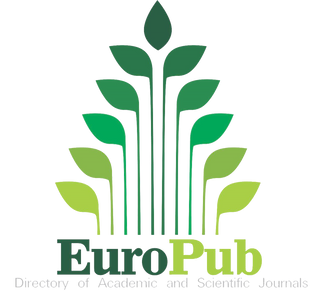Određivanje sadržaja fenolnih jedinjenja i antioksidacijskog kapaciteta ekstrakata lišća i kore Fraxinus excelsior L. i Fraxinus anfustifolia Vahl.
DOI:
https://doi.org/10.54652/rsf.2016.v46.i1.77Ključne riječi:
Fraxinus, F. excelsior, F. angustifolia, phenols, DPPH, FRAPSažetak
UDK: 581.19:547.56]:582.916.16
Metanolni ekstrakti uzoraka lista i kore grana F. excelsior L. i F. angustifolia Vahl. ispitivani su na sadržaj ukupnih fenola, flavonoida, fenolnih kiselina, kumarina i proantocijanidina kao i antioksidacijsku aktivnost. Spektofotometrijske metode su korištene za određivanje sadržaja bioaktivnih jedinjenja i antioksidacijske aktivnosti ekstrakata lista i kore. Ukupni fenoli su određeni Folin-Ciocalteu metodom a određivanje ukupnih flavonoida prema rutinu i kvercitinu kao standardima rađeno je AlCl3 metodom. Kiselinsko-butanolna metoda je upotrebljena za kvantifikaciju ukupnih proantocijanidina. Ukupne fenolne kiseline su određene Arnovom metodom a ukupni kumarini metodom Osoria i Martineza (2004). Za mjerenje antioksidacijske aktivnosti korištene su DPPH i FRAP metoda uz primjenu askorbinske kiseline i Fe(II) sulfata kao standarda.
Sadržaj ukupnih fenola po gramu suhog uzorka (s.u) za uzorke listova varira od 23.94 – 46.98 mg GAE g-1 s.u; ukupnih flavonoida 6.30 – 9.14 mg RE g-1 s.u. i 3.67 – 5.34 mg QE g-1 s.u; fenolnih kiselina 9.85 – 24.94 mg CAE g-1; sadržaj ukupnih kumarina iznosili su 20.18 – 41.72 mg CE g-1 s.u. i proantocijanidina 2.90 -11.16 mg LCE g-1 s.u.
U uzorcima kore grana sadržaj ispitivanih jedinjenja iznosio je: ukupni fenoli 22.77 – 39.85 mg GAE g-1 s.u; ukupni flavonoidi 0.91 – 1.74 mg RE g-1 s.u i 0.64 – 0.95 mg QE g-1 s.u; ukupne fenolne kiseline su bile u granicama 17.79 – 36.67 mg CAE g-1, a ukupni kumarini 27.91 – 70.98 mg CE g-1 s.u; i ukupni proantocijanidini 3.8 – 7.95 mg LCE g-1 s.u.
Poređenjem prosječnih sadržaja aktivnih jedinjenja u listovima i kori dvije vrste može se zaključiti da F. angustifolia ima veći prosječni sadržaj svih ispitivanih jedinjenja u odnosu na F. excelsior, izuzev proantocijanidina koji su veći u kori F. excelsior.
Antioksidacijski kapaciteti za F. excelsior kretali su se u području: 16.49 – 18.84 i mg AAE g-1 s.u (za list) i 16.65 – 23.99 mg AAE g-1 s.u. (za koru) dok su vrijednosti antioksidacijskog kapaciteta bili u području 29.30 – 42.18 mg AAE g-1 s.u za listove F. angustifolia i za koru 28.64 – 41.99 mg AAE g-1 s.u.
Vrijednosti antioksidacijskog kapaciteta (FRAP) iznosili su za listove i koru F. excelsior 781.10 – 874 µmolFe(II) g-1 s.u i 713.94 – 1087.56 µmolFe(II) g-1 s.u . Za list i koru F. angustifolia vrijednosti FRAPA su bile u granicama 1101- 1870 µmolFe(II) g-1 s.u i 1255.27 – 1743 µmolFe(II) g-1 s.u.
Na osnovu dobivenih podataka za prosječne vrijednosti antioksidacijskog kapaciteta, može se zaključiti da listovi i kora F. angustifolia imaju bolja antioksidacijska svojstva.
Linearnom regresijom između sadržaja aktivnih komponenti i antioksidacijskog kapaciteta određeni su koeficijenti korelacije (r2). Utvrđeno je postojanje visoke korelacije između ukupnih fenola, fenolnih kiselina i kumarina i antioksidacijskog kapaciteta za list i koru.
Na osnovu dobivenih rezultata može se zaključiti da list i kora grana običnog i poljskog jasena predstavljaju značajan potencijalni izvor prirodnih supstanci antioksidativnog karaktera.
Downloads
References
ATMANI, D., CHAHER, N., BERBOUCHA, M., AYOUNI, K., LOUNIS, H., BOUDAOUD, H., DEBBACHE, N., ATMANI D. (2009). Antioxidant capacity and phenol content of selected Algerian medicinal plants, Food Chemistry, 112, 303-309.
AYOUNI, K., BERBOUCHA-RAHMANI, M., KIM, H.K., ATMANI, D., VERPOORTE, R., CHOI, Y.H. (2016): Metabolomic tool to identify antioxidant compounds of Fraxinus angustifolia leaf and stem bark extracts. Industrial Crops and Products, htpp://dx.doi.org/10.1016/j.indcrop.2016.01.001.
BABBA AÏSSA F. (1999): Encyclopedia useful plants. Flora of Algeria and the Maghreb. Vegetable substances from Africa, East and the West. Modern Library Rouiba, EDAS, Algiers, Algeria.
BALLIAN, D., MONTELEONE, I., FERAZZINI, D., KAJBA, D., BALLETI, P. (2008): Genetic characterisation of common ash (Fraxinus excelsior L.) populations in Bosnia and Herzegovina. Periodicum Biologicum, vol 110, no 4, 323-328.
BENZIE I.F. AND STRAIN J.J. (1996): The ferric reducing ability of plasma (FRAP) as a measure of "antioxidant power": the FRAP assay. Analytical Biochemistry, 239(1) 70-6.
BERBOUCHA, M., AYOUNI, K., ATMANI, D., ATMANI, D., BENBOUBETRA, M. (2010): Kinetic Study on the Inhibition of Xanthine Oxidase by Extracts from Two Selected Algerian Plants Traditionally Used for the Treatment of Inflammatory Diseases. Journal of Medicinal Food, 13(4), 1-9.
CARNAT, A., LAMAISON, J.L., DUBAND, F. (1990): Teneurs en principaux constituants de la feuille de frêne, Fraxinus excelsior L. Plantes Médicinales et Phytotérapie, 24:145-151.
EUROPEAN MEDICINAL AGENCY (2012): Assessment report on Fraxinus excelsior L. or Fraxinus angustifolia Vahl folium. London, United Kingdom.
FERNANDEZ-MANJARRES, J.F., GERARD, P.R., DUFOUR, J. RAANIN, C., FRASCARIA- LACOSTE, N. (2006): Differential patterns of morphological and molecular hybridisation between Fraxinus excelsior L. and Fraxinus angustifolia Vahl (Oleacea) in eastern and western France. Molecular Ecology, 15, 3245-3257.
GAEDCKE, F. (1993): Fraxinus. In: Hänsel R, Keller K, Rimpler H, Schneider G, editors. Hagers Handbuch der Pharmazeutischen Praxis. Drogen E-O, Vol 5. 5th ed. Springer-Verlag, Berlin, 188-200.
GAWLIC-DZIKI, U. (2012): Dietary spices as natural effectors of lipoxygenase, xanthine oxidase, peroxidase and antioxidant agents. LTW-Food Science and Technology, 47, 138-146.
HAGERMAN, A., HARVEY-MUELLER, I., MAKKAR, H.P.S. (2000b): Quantification of tannins in tree foliage – a laboratory manual. FAO/IAEA, Vienna, pp.4-7.
IORDACHE, T.A., VLASE, L., ISTUDOR, V., GIRD, C.E. (2013): Researches regarding obtaining selective extracts with hypoglycemiant properties from vegetal indigenous products (Cichorii Herba and Fraxini folium). Note III Phenolic compounds analysis from Fraxini folium. Farmacia, 61, 4. 625-631.
KOSTOVA, I. (2001): Fraxinus ornus L. Fitoterapia, 72, 471-480.
KOSTOVA, I. ,. BHATIA, S , GRIGOROV , P. , BALKANSKY , S. , PARMAR, V.S. ,. PRASAD A.K , SASO, L. (2011): Coumarins as antioxidants. Current Medicinal Chemistry, 18, 3929-3951.
KOSTOVA, I., AND IOSSIFOVA, T. (2007): Chemical components of Fraxinus species. Fitotrapia, 78, 85-106.
LI, H.B., WONG, C.C., CHENG, K.W., CHEN, F. (2008): Antioxidant properties in vitro and total phenolic contents in methanol extracts from medicinal plants, LWT, 41, 385-390.
LUST, J. (1974): The Herbal Book. Benedict Lust Publications, USA , 298-300.
MAYER, B., SCHNEIDER, W., ELSTNER, E.F. (1995): Antioxidant properties of alcoholic extracts from Fraxinus excelsior, Populus tremula, and Solidago virganrea. Arzneimittelforschung, 45, 174-176.
MURRAY, R.D.H., MENDEZ, J., BRAUN, S.A. (1982): The natural coumarins. Chichester. John Wiley and Sons, 513.
NYKOLOV, N., IOSSIFOVA, T., VASSILEVA, E, KOSTOVA, I., STOEV, G. (1993): Reverse-phase high pressure liquid chromatographic analysis of hydroxycoumarins in plant extracts. Quantitative determination of hydroxycoumarins in Fraxinus ornus. Phytochemical Analysis, 4-86.
ORDONEZ, A.A., GOMEZ, J.G., VATTUONE, M.A. AND ISLA, M.I. (2006): Antioxidant activities of Sechium edule swart extracts. Food Chemistry, 97: 452-458.
OSORIO, O.K. AND MARTINS, J.L.S. (2004): Determinacao de cumarina em extrato fluido tintura de guaco por espectrofotometria derivada de primeira ordem. Brazilian Journal of Pharmaceutical Sciences, 40(4): 481 486.
PRIOR, R.L., WU, X., SCHAICH, K. (2005): Standardized methods for the determination of antioxidant capacity and phenols in foods and dietary supplements. Journal of Agricultural Food Chemistry, 53, 4290-4302
QUETTIER, D.C., GRESSIER, B., VASSEUR, J., DINE, T., BRUNET, C., LUYCK, M.C., CAYIN, J.C., BAILLEUL, F., TROTIN, F. (2000): Phenolic compounds and antioxidant activities of buckwheat (Fagopyrum esculentum Moench) hulls and flour. Journal of Ethnopharmacology, 118, 418-428.
RAQUIN, C., JUNG-MULLER, B., DUFOUR, J., FRASCARIA-LACOSTE, N. (2002): Rapid seedling obtaining from European ash species Fraxinus excelsior L. and Fraxinus angustifolia (Vahl.) Anw For. Sci., 59, 219-224.
SANCEZ-MORENO, C., LARRAURI, J.A., SAURA-CALIXTO, F. (1998): A procedure to measure the antiradical efficiency of polyphenols. Journal of Science Food Agriculture, 76, 270-276.
STEVANOVIĆ, V., BEUS, V., BURULICA, Č., DIZDAREVIĆ, H., VUKOREP, I. (1983): Ekološko-vegetacijska rejonizacija Bosne i Hercegovine, sarajevo, Šumarski fakultet, posebna izdanja br 17.
SINGLETON, V.L., ORTHOFER, R., LAMUELA-RAVENTOS, R.M. (1974): Analysis of total phenols and other oxidation substrates and antioxidants by means of Folin-Ciocalteu reagent. Methods of Enzymology, 229, 152-178.
TAHIROVIĆ, A., BAŠIĆ, N., HUBIJAR, I., ŠITO, S., ČABARAVDIĆ, A. (2015): Comparison of polyphenol content and antioxidant activity of extracts from fruits of two Crataegus species. Works of the Faculty of Forestry University of Sarajevo, 45(1), 38-51.
TANG, W. AND EISENBRAND, G. (1992): Chinese drugs of plant origin: chemistry, pharmacology and use in traditional and modern medicine, Springer-Verlag, Berlin Heideberg, 521-523.
WALLANDER, E. (2008): Systematics of Fraxinus (Oleacae) and evolution of dioecy. Plant Systematics and Evolution, 273, 25-49.
WEI, Z. AND GREEN, P.S. (1996): Fraxinus In: Wu, Z., Raven, P.H. (Eds). Flora of China, vol 15. Science press & Missouri Botanical garden, Beijing and St. Louis, pp. 273-279.
WRIGHT, C.I., VAN-BUREN, L., KRONER, C.I., KONINGEN, M.M.G. (2007): Herbal medicines as diuretics. A review of the scientific evidence. Journal of Ethnopharmacology, 114, 1-31.
WU, C.R., HUANG, M.Y., LIN, Y.T., JU, H.Y., CHING, H. (2007): Antioxidant properties of Cortex Fraxini and its simple coumarins. Food Chemistry, 104: 1464-71.























